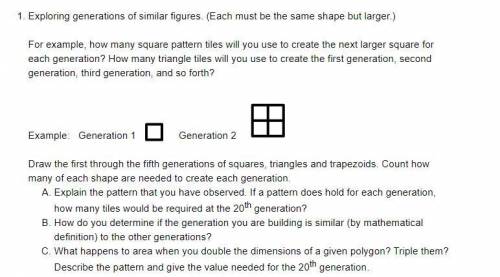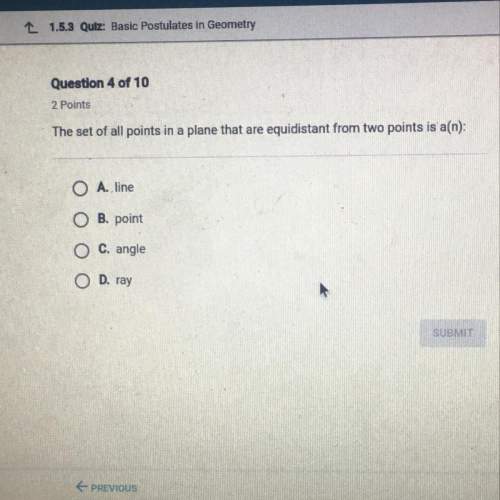
Mathematics, 03.11.2020 02:00 mchillery1028
Exploring generations of similar figures. (Each must be the same shape but larger.)
For example, how many square pattern tiles will you use to create the next larger square for each generation? How many triangle tiles will you use to create the first generation, second generation, third generation, and so forth?
Example: LOOK AT IMAGE
Draw the first through the fifth generations of squares, triangles and trapezoids. Count how many of each shape are needed to create each generation.
Explain the pattern that you have observed. If a pattern does hold for each generation, how many tiles would be required at the 20th generation?
How do you determine if the generation you are building is similar (by mathematical definition) to the other generations?
What happens to area when you double the dimensions of a given polygon? Triple them? Describe the pattern and give the value needed for the 20th generation.


Answers: 3
Another question on Mathematics

Mathematics, 21.06.2019 20:00
Ke’ajah has a coupon for 1/3 off the regular price, t, of a tent. which expression represents the price of the tent using the coupon? select the two correct expressions. a. 1/3t b. 2/3t c. t - 1/3 d. t - 2/3 e. t - 1/3t f. t - 2/3t
Answers: 1

Mathematics, 22.06.2019 03:00
The biologist has a second culture to examine. she knows that the population of the culture doubles every 15 minutes. after 1 hour and 15 minutes, her assistant found that 80,000 bacteria were present. a) what was the size of the initial population? b) predict the size of the culture at t=3 hours. what was the size of the population at 40 minutes? explain and justify your answers. c) create a graph of the population as a function of time. find an equation that can be used to predict the size of the population at any time t. d) examine the rate at which the bacteria culture is growing. how fast is the culture growing after 1 hour? after 1.5 hours? after 2 hours? use a time interval of h = 0.01 hours to estimate these rates. interpret these rates in terms of the context of the problem situation. how do these three rates compare?
Answers: 1

Mathematics, 22.06.2019 03:00
Describe a pattern in each sequence what are the next two terms of each sequence -5, 5, -5, 5 a. subtract 10 from the previous term; -5,5 b. multiply the previous term by 1; 5, 5 c. add 10 to the previous term; -5, -15 d. multiply the previous term by -1; -5, 5
Answers: 1

Mathematics, 22.06.2019 03:00
Which equation represents h in the triangle? a) h = 6sin37° b) h = 10sin37° c) h = 6 10 sin37° d) h = 10 6 sin37°
Answers: 1
You know the right answer?
Exploring generations of similar figures. (Each must be the same shape but larger.)
For example, ho...
Questions

Social Studies, 10.09.2021 18:50



Biology, 10.09.2021 18:50


Mathematics, 10.09.2021 18:50


Mathematics, 10.09.2021 18:50

Social Studies, 10.09.2021 18:50

English, 10.09.2021 18:50


Mathematics, 10.09.2021 18:50



Social Studies, 10.09.2021 18:50

Social Studies, 10.09.2021 18:50

Mathematics, 10.09.2021 18:50

Mathematics, 10.09.2021 18:50


Social Studies, 10.09.2021 18:50




